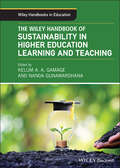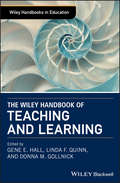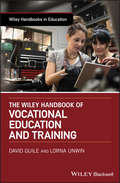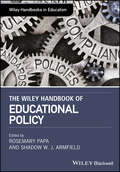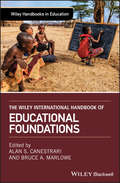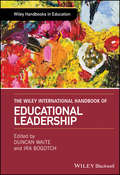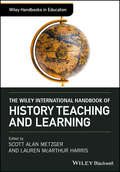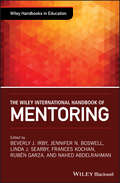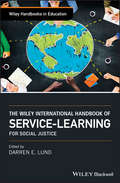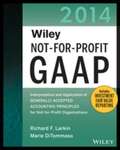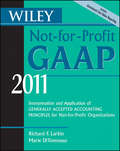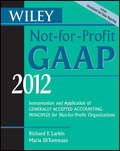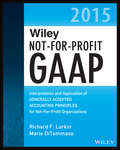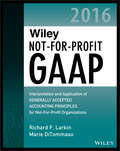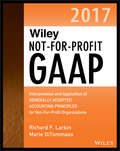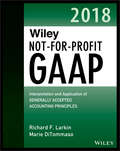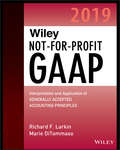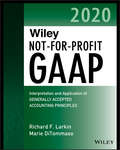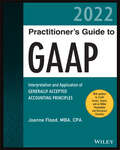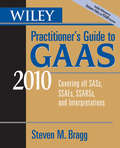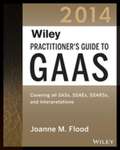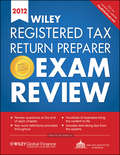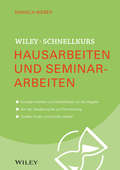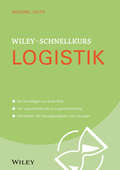- Table View
- List View
The Wiley Handbook of Sustainability in Higher Education Learning and Teaching (Wiley Handbooks in Education)
by Kelum A. A. Gamage Nanda GunawardhanaA comprehensive resource for higher education professionals interested in sustainability pedagogy In The Wiley Handbook of Sustainability in Higher Education Learning and Teaching, a team of distinguished researchers delivers an insightful reference for higher education professionals seeking to embed sustainability in learning and teaching. The book offers a way for higher education institutions to implement sustainability goals in their curricula and provides comprehensive guidance to educators, researchers and practitioners. The authors discuss recent developments in technological innovations, best practices, lessons learned, current challenges, and reflections in the area of sustainability teaching in higher education. They also examine the impact of the COVID-19 pandemic on sustainability education. With contributors from a variety of disciplines, including engineering, medicine, urban design, business, environmental science, and social science, the book considers the embedding of sustainability in regenerative learning ecologies, living laboratories, and transgressive forms of learning. It also includes: A thorough introduction to activist learning for sustainability and outcome-based education towards achieving sustainable goals in higher education Comprehensive explorations of factors that hinder the implementation of sustainability initiatives in higher education institutions Practical discussions of developing stakeholder agency in higher education sustainability initiatives In-depth examinations of global trends and country-specific initiatives in sustainability teaching Perfect for education developers seeking to incorporate sustainability, The Wiley Handbook of Sustainability in Higher Education Learning and Teaching is also ideal for academics, researchers, policymakers, and accreditation personnel working in the area of sustainability.
The Wiley Handbook of Teaching and Learning (Wiley Handbooks in Education)
by Gene E. Hall Linda F. Quinn Donna M. GollnickProvides a comprehensive reference for scholars, educators, stakeholders, and the general public on matters influencing and directly affecting education in today’s schools across the globe This enlightening handbook offers current, international perspectives on the conditions in communities, contemporary practices in schooling, relevant research on teaching and learning, and implications for the future of education. It contains diverse conceptual frameworks for analyzing existing issues in education, including but not limited to characteristics of today’s students, assessment of student learning, evaluation of teachers, trends in teacher education programs, technological advances in content delivery, the important role for school leaders, and innovative instructional practices to increase student learning. The Wiley Handbook of Teaching and Learning promotes new, global approaches to studying the process of education, demonstrates the diversity among the constituents of schooling, recognizes the need for and presents a variety of approaches to teaching and learning, and details exemplary practices in education. Divided into four sections focused on general topics—context and schooling; learners and learning; teachers and teaching; and educators as learners and leaders—and with all-new essays that look at what has been, what is, and what could be, this book is destined to inspire thoughtful contemplation from readers about what it means to teach and learn. Examines teaching, learners, and learning from a contemporary, international perspective, presenting alternative views and approaches Provides a single reference source for teachers, education leaders, and agency administrators Summarizes recent research and theory Offers evidence-based recommendations for practice Includes essays from established and emerging U.S. and international scholars Each chapter includes a section encouraging readers to think ahead and imagine what education might be in the future Scholars from around the world provide a range of evidence-based ideas for improving and modifying current educational practices, making The Wiley Handbook of Teaching and Learning an important book for the global education community and those planning on entering into it.
The Wiley Handbook of Vocational Education and Training (Wiley Handbooks in Education)
by David Guile Lorna UnwinA collection of the theories, practices, and policies of vocational education and training written by international experts The Wiley Handbook of Vocational Education and Training offers an in-depth guide to the theories, practices, and policies of vocational education and training (VET). With contributions from a panel of leading international scholars, the Handbook contains 27 authoritative essays from a wide range of disciplines. The contributors present an integrated analysis of the complex and dynamic field of VET. Drawing on the most recent research, thinking, and practice in the field, the book explores the key debates about the role of VET in the education and training systems of various nations. The Handbook reveals how expertise is developed in an age of considerable transformation in work processes, work organization, and occupational identities. The authors also examine many of the challenges of vocational education and training such as the impact of digital technologies on employment, the demand for (re)training in the context of extended working lives, the emergence of learning regions and skill ecosystems, and the professional development of vocational teachers and trainers. This important text: Offers an original view of VET’s role in both the initial and continuing development of expertise Examines the theories and concepts that underpin international perspectives and explores the differences about the purposes of VET Presents various models of learning used in VET, including apprenticeship, and their relationship with general education Explores how VET is shaped in different ways by the political economy of different countries Reviews how developments in digital technologies are changing VET practice Discusses the challenges for universities offering higher vocational education programs Draws on both recent research as well as historical accounts Written for students, researchers, and scholars in the fields of educational studies, human resource development, social policy, political economy, labor market economics, industrial relations, sociology, The Wiley Handbook of Vocational Education and Training offers an international perspective on the topic of VET.
The Wiley Handbook of Educational Policy (Wiley Handbooks In Education Ser.)
by Rosemary Papa Shadow W. J. ArmfieldIlluminates the multiple barriers that plague the education system and shows the way toward enlightened and inclusive educational policy and policymaking This book showcases new scholarship in the broad field of education policy and governance. Authored by some of the field’s foremost scholars, as well as new and up-and-coming academics, this definitive handbook offers a range of cultural, economic, and political perspectives on the state of education policy today. It addresses historic, current, and future education policy—incorporating changing social landscapes of education, economy, and policy. The Wiley Handbook of Educational Policy covers the role of politics in education governance; the politics of philanthropy and for-profits; the culture and economy of professional organizations; the governance of technology integration; and future political realities to global citizenry. Themes and topics range not only across early childhood, K-12, and tertiary forms of schooling, but also across the policy questions and concerns that transcend these distinctions. Each chapter features key words, key questions, conclusions, and thought-provoking ideas that provoke readers to think about ways to improve the current conditions under which educational policy-makers work. Provides a traditional understanding of educational policy Shows how educational policy has changed due to the boom of private funding Explores the changing demographics in education populations over the last 40 years Discusses policies and the ethics of using and overseeing technology in teaching and learning environments Looks at future trends from contemporary political origins The Wiley Handbook of Educational Policy is an important book that should be read by every administrator, policy maker, and educator working in the education system.
The Wiley Handbook on Violence in Education: Forms, Factors, and Preventions (Wiley Handbooks in Education)
by Harvey ShapiroIn this comprehensive, multidisciplinary volume, experts from a wide range fields explore violence in education’s different forms, contributing factors, and contextual nature. With contributions from noted experts in a wide-range of scholarly and professional fields, The Wiley Handbook on Violence in Education offers original research and essays that address the troubling issue of violence in education. The authors show the different forms that violence takes in educational contexts, explore the factors that contribute to violence, and provide innovative perspectives and approaches for prevention and response. This multidisciplinary volume presents a range of rigorous research that examines violence from both micro- and macro- approaches. In its twenty-nine chapters, this comprehensive volume’s fifty-nine contributors, representing thirty-three universities from the United States and six other countries, examines violence’s distinctive forms and contributing factors. This much-needed volume: Addresses the complexities of violence in education with essays from experts in the fields of sociology, psychology, criminology, education, disabilities studies, forensic psychology, philosophy, and critical theory Explores the many forms of school violence including physical, verbal, linguistic, social, legal, religious, political, structural, and symbolic violence Reveals violence in education’s stratified nature in order to achieve a deeper understanding of the problem Demonstrates how violence in education is deeply situated in schools, communities, and the broader society and culture Offers new perspectives and proposals for prevention and response The Wiley Handbook on Violence in Education is designed to help researchers, educators, policy makers, and community leaders understand violence in educational settings and offers innovative, effective approaches to this difficult challenge.
The Wiley International Handbook of Educational Foundations (Wiley Handbooks in Education)
by Alan S. Canestrari Bruce A. MarlowePromotes a model of critique for teachers, scholars, and policy makers to challenge established educational practice in a global context. The Wiley International Handbook of Educational Foundations features international scholars uniquely qualified to examine issues specific to their regions of the world. The Handbook provides readers with an alternative to the traditional texts in the foundations of education by taking aim at the status quo, and by offering frameworks from which teachers and scholars of education can critically evaluate schools and schooling. Throughout, the essays are grounded in a broad historical context and the authors use an international lens to examine current controversies in order to provoke the kinds of discussion crucial for developing a critical stance. The Handbook is presented in six parts, each beginning with an Introduction to the subject. The sections featured are: Part I. Challenging Foundational Histories and Narratives of Achievement; Part II. Challenging Notions of Normalcy and Dominion; Part III. Challenging the Profession; Part IV. Challenging the Curriculum; Part V. Challenging the Idea of Schooling; and Part VI. Challenging Injustice, Inequity, and Enmity. The Wiley International Handbook of Educational Foundations offers unique insight into subjects such as: Educational reform in India, Pakistan, and China The global implications of equity-driven education Teacher education and inclusionary practices The Global Educational Reform Movement (G.E.R.M.) Education and the arts Maria Montessori and Loris Malaguzzi Legal education in authoritarian Syria The Wiley International Handbook of Educational Foundations is an important book for current and aspiring educators, scholars, and policy makers.
The Wiley International Handbook of Educational Leadership (Wiley Handbooks in Education)
by Duncan Waite Ira BogotchA provocative and authoritative compendium of writings on leadership in education from distinguished scholar-educators worldwide. What is educational leadership? What are some of the trends, questions, and social forces most relevant to the current state of education? What are the possible futures of education, and what can educational leadership contribute to these futures? To address these questions, and more, editors Duncan Waite and Ira Bogotch asked distinguished international thought leaders on education to share their insights, observations, and research findings on the nature of education and educational leadership in the global village. The Wiley International Handbook of Educational Leadership brings together contributions from authors in twenty-one countries, spanning six continents. Topics examined include leadership and aesthetics, creativity, eco‐justice, advocacy, Big Data and technology, neoliberalism, emerging philosophies and theories, critical democracy, gender and radical feminism, political economies, emotions, postcolonialism, and new directions in higher education. A must-read for teachers, researchers, scholars, and policy makers, this Handbook: Champions radical pluralism over consensus and pseudoscientific or political solutions to problems in education Embraces social, economic, and political relevance alongside the traditions of careful and systematic rigor Challenges traditional epistemological, cultural, and methodological concepts of education and educational leadership Explores the field’s historical antecedents and ways in which leadership can transcend the narrow disciplinary and bureaucratic constraints imposed by current research designs and methods Advances radically new possibilities for remaking educational leadership research and educational institutions
The Wiley International Handbook of History Teaching and Learning (Wiley Handbooks in Education)
by Scott Alan Metzger Lauren McArthur HarrisA comprehensive review of the research literature on history education with contributions from international experts The Wiley International Handbook of History Teaching and Learning draws on contributions from an international panel of experts. Their writings explore the growth the field has experienced in the past three decades and offer observations on challenges and opportunities for the future. The contributors represent a wide range of pioneering, established, and promising new scholars with diverse perspectives on history education. Comprehensive in scope, the contributions cover major themes and issues in history education including: policy, research, and societal contexts; conceptual constructs of history education; ideologies, identities, and group experiences in history education; practices and learning; historical literacies: texts, media, and social spaces; and consensus and dissent. This vital resource: Contains original writings by more than 40 scholars from seven countries Identifies major themes and issues shaping history education today Highlights history education as a distinct field of scholarly inquiry and academic practice Presents an authoritative survey of where the field has been and offers a view of what the future may hold Written for scholars and students of education as well as history teachers with an interest in the current issues in their field, The Wiley International Handbook of History Teaching and Learning is a comprehensive handbook that explores the increasingly global field of history education as it has evolved to the present day.
The Wiley International Handbook of Mentoring (Wiley Handbooks In Education Ser.)
by Beverly J. Irby Jennifer N. Boswell Linda J. Searby Frances Kochan Rub N Garza Nahed AbdelrahmanThe first collection in the area of mentoring that applies theory to real-world practice, research, programs, and recommendations from an international perspective In today’s networked world society, mentoring is a crucial area for study that requires a deep international understanding for effective implementation. Despite the immense benefits of mentoring, current literature on this subject is surprisingly sparse. The Wiley International Handbook of Mentoring fills the need for a comprehensive volume of in-depth information on the different types of mentoring programs, effective mentoring practices, and emerging practical and applicable theories. Based on sound research methodologies, this unique text presents original essays by experts from over ten different countries, demonstrating the ways mentoring can make a difference in the workplace and in the classroom; these experts have an understanding of mentoring worldwide having worked in mentoring in over forty countries. Each of the Handbook’s four sections—mentoring paradigms, practices, programs, and possibilities—include a final synthesis chapter authored by the section editors that captures the essence of the lessons learned, applies a global context, and recommends research avenues for further exploration. This innovative volume demonstrates how mentoring in any culture can help employees to complete tasks and advance in their positions, aid in socialization and assimilation in various settings, provide diverse groups access to resources and information, navigate through personalities, politics, policies, and procedures, and much more. Offers an inclusive, international perspective that supports moving mentoring into a discipline of its own and lays a theoretical foundation for further research Shows how emerging practical theories can be implemented in actual programs and various scenarios Examines a wide range of contemporary paradigms, practices, and programs in the field of mentoring, including a panorama of introspections on mentoring from international scholars and practitioners Includes historical and epistemological content, background information and definitions, and overviews of fundamental aspects of mentoring The Wiley International Handbook of Mentoring is an essential volume for a global readership, particularly teachers of mentoring courses, trainers, and researchers and practitioners in a variety of fields such as business, education, government, politics, sciences, industry, or sports.
The Wiley International Handbook of Service-Learning for Social Justice (Wiley Handbooks in Education)
by Darren E. LundA comprehensive guide to service-learning for social justice written by an international panel of experts The Wiley International Handbook of Service-Learning for Social Justice offers a review of recent trends in social justice that have been, until recently, marginalized in the field of service-learning. The authors offer a guide for establishing and nurturing social justice in a variety of service-learning programs, and show that incorporating the principles of social justice in service-learning can empower communities to resist and disrupt oppressive power structures, and work for solidarity with host and partner communities. With contributions from an international panel of experts, the Handbook contains a critique of the field’s roots in charity; a review of the problematization of Whitenormativity, paired with the bolstering of diverse voices and perspectives; and information on the embrace of emotional elements including tension, ambiguity, and discomfort. This important resource: Considers the role of the community in service-learning and other community‑engaged models of education and practice Explores the necessity of disruption and dissonance in service-learning Discusses a number of targeted issues that often arise in service-learning contexts Offers a practical guide to establishing and nurturing social justice at the heart of an international service-learning program Written for advanced undergraduate students, graduate students, scholars, and educators, The Wiley International Handbook of Service-Learning for Social Justice highlights social justice as a conflict‑ridden struggle against inequality, xenophobia, and oppression, and offers practical suggestions for incorporating service-learning programs in various arenas.
Wiley Not-for-Profit GAAP 2011
by Richard F. Larkin Marie DitommasoThe most practical, authoritative guide to not-for-profit GAAPWiley Not-for-Profit GAAP 2011 is a comprehensive, easy-to-use guide to the accounting and financial reporting principles used by not-for-profit organizations. Written with the needs of the financial statement preparer, user, and attestor in mind, this guide provides a complete review of the authoritative accounting literature that impacts all types of not-for-profit organizations. At the same time, Wiley Not-for-Profit GAAP 2011 features many examples and illustrations that will assist professionals in applying authoritative literature to real-life situations.Easy-to-use information that enables users to find needed information quicklyCoverage of accounting principles specifically related to not-for-profit organizations, as well as accounting principles applicable to all types of organizationsSpecific coverage of accounting issues for different types of not-for-profit organizationsA comprehensive disclosure checklist that helps financial statement preparers and attestors ensure that all disclosures required by GAAP have been consideredMany examples and illustrations that make putting accounting theory into practice an easy taskDestined to become the reference you keep at your side, Wiley Not-for-Profit GAAP 2011 strives to be a thorough, reliable reference that nonprofit accounting professionals will use constantly.
Wiley Not-for-Profit GAAP 2011: Interpretation and Application of Generally Accepted Accounting Principles
by Richard F. Larkin Marie DiTommasoThe most practical, authoritative guide to not-for-profit GAAP Wiley Not-for-Profit GAAP 2011 is a comprehensive, easy-to-use guide to the accounting and financial reporting principles used by not-for-profit organizations. Written with the needs of the financial statement preparer, user, and attestor in mind, this guide provides a complete review of the authoritative accounting literature that impacts all types of not-for-profit organizations. At the same time, Wiley Not-for-Profit GAAP 2011 features many examples and illustrations that will assist professionals in applying authoritative literature to real-life situations. Easy-to-use information that enables users to find needed information quickly Coverage of accounting principles specifically related to not-for-profit organizations, as well as accounting principles applicable to all types of organizations Specific coverage of accounting issues for different types of not-for-profit organizations A comprehensive disclosure checklist that helps financial statement preparers and attestors ensure that all disclosures required by GAAP have been considered Many examples and illustrations that make putting accounting theory into practice an easy task Destined to become the reference you keep at your side, Wiley Not-for-Profit GAAP 2011 strives to be a thorough, reliable reference that nonprofit accounting professionals will use constantly.
Wiley Not-for-Profit GAAP 2012: Interpretation and Application of Generally Accepted Accounting Principles
by Richard F. Larkin Marie DiTommasoThe most practical, authoritative guide to not-for-profit GAAP Wiley Not-for-Profit GAAP 2012 is a comprehensive, easy-to-use guide to the accounting and financial reporting principles used by not-for-profit organizations. Written with the needs of the financial statement preparer, user, and attestor in mind, this guide provides a complete review of the authoritative accounting literature that impacts all types of not-for-profit organizations. At the same time, Wiley Not-for-Profit GAAP 2012 features many examples and illustrations that will assist professionals in applying authoritative literature to real-life situations. Easy-to-use information that enables users to find needed information quickly Coverage of accounting principles specifically related to not-for-profit organizations, as well as accounting principles applicable to all types of organizations Specific coverage of accounting issues for different types of not-for-profit organizations A disclosure checklist that helps financial statement preparers and attestors ensure that all disclosures required by GAAP have been considered Flowcharts, diagrams, and charts, wherever possible, to help facilitate the user's understanding of the material presented Destined to become the reference you keep at your side, Wiley Not-for-Profit GAAP 2012 strives to be a thorough, reliable reference that nonprofit accounting professionals will use constantly.
Wiley Not-for-Profit GAAP 2015
by Richard F. Larkin Marie Ditommaso Warren RuppelDetailed, practical coverage of GAAP, tailored to not-for-profitorganizations Wiley Not-for-Profit GAAP 2015 is a thorough examinationof the authoritative standards for measurement, presentation, anddisclosure as applied to not-for-profit organizations. Clear andconcise, this user-friendly guide explains the fundamentals of GAAPin an easily-accessible format that includes flowcharts anddiagrams to help facilitate the reader's understanding of thematerial presented, including a financial statement disclosurechecklist to confirm GAAP adherence. Designed specifically foraccountants in public practice and industry, this guide covers allrelevant FASB and AICPA guidelines, to provide a complete referencetool for auditors who need a comprehensive understanding of GAAPfor not-for-profit organizations.Due to these organizations' unique characteristics,not-for-profit accountants must adhere to specific GenerallyAccepted Accounting Principles. These requirements are complex andever evolving, but Wiley Not-for-Profit GAAP 2015 bringsthem together in a single volume that contains the mostup-to-the-minute information available.Refine basic financial statements, including FinancialPosition, Activities, and Cash FlowTackle not-for-profit-specific issues like fundraising, noncashcontributions, affiliations, and pledgesTailor accounting methods to the specific type of organization,with budgeting, tax reporting, and regulatory adviceDiscover how general accounting topics like assets, mergers,and liabilities are applied to not-for-profit organizationsPreparers and auditors of not-for-profit accounts must stayup-to-date on the latest GAAP practices to best serve theorganization, while complying with all disclosure, reporting, andregulatory requirements. Wiley Not-for-Profit GAAP 2015provides extensive coverage and practical advice on the latestGAAP, tailored to the not-for-profit organization's uniqueneeds.
Wiley Not-for-Profit GAAP 2016: Interpretation and Application of Generally Accepted Accounting Principles
by Richard F. Larkin Marie DitommasoDetailed, practical coverage of GAAP, tailored to not-for-profit organizations Wiley Not-for-Profit GAAP 2016 is a thorough examination of the authoritative standards for measurement, presentation and disclosure as applied to not-for-profit organizations. Due to these organizations' unique characteristics, not-for-profit accountants must adhere to specific Generally Accepted Accounting Principles (GAAP). These requirements are complex and ever evolving, but this single volume brings them together, providing the most up-to-date information available. Flowcharts and diagrams are used to assist the reader's understanding of the material. Additionally, a financial statement disclosure checklist facilitates GAAP adherence. Designed specifically for accountants in public practice and industry, this guide covers requirements from all relevant organizations, including the Financial Accounting Standards Board (FASB) and Accounting Principles Board (APB). Technical and accounting research bulletins are clearly and concisely summarized, as are all statements of position important to not-for-profit organizations. Together, these resources make Wiley Not-for-Profit GAAP 2016 a complete reference tool for auditors and financial personnel in the not-for-profit sector. Refine basic financial statements, including Financial Position, Activities and Cash Flow Tackle not-for-profit-specific issues like fundraising, noncash contributions, affiliations and pledges Tailor accounting methods to the specific type of organization, with budgeting, tax reporting and regulatory advice Discover how general accounting topics like assets, mergers and liabilities are applied to not-for-profit organizations Preparers and auditors of not-for-profit accounts must stay up-to-date on the latest GAAP practices to best serve the organization, while complying with all disclosure, reporting and regulatory requirements. Wiley Not-for-Profit GAAP 2016 provides extensive coverage and practical advice on the latest GAAP, tailored to the not-for-profit organization's unique needs.
Wiley Not-for-Profit GAAP 2017: Interpretation and Application of Generally Accepted Accounting Principles
by Marie Ditommaso Richard F. Larkin Warren RuppelThe essential not-for-profit GAAP reference, updated with the latest standards Wiley Not-for-Profit GAAP 2017 is the essential accounting resource for not-for-profit organizations, providing quick access to the most up-to-date standards and practical tools for implementation. Designed help you find the answers you need quickly and easily, this guide features helpful visual aids alongside detailed explanations tailored to the not-for-profit sector. Authoritative discussion covers Financial Accounting Standards Board (FASB) Accounting Standards Codification, which includes the standards originally issued in the Statements, Interpretations and Technical Bulletins; Accounting Principles Board Opinions, Accounting Research Bulletins, AICPA Statements of Position and FASB Emerging Issues Task Force statements relevant to the not-for-profit organization. The unique characteristics of the not-for-profit organization demand adherence to specific GAAP; auditors and preparers must understand these standards, stay up-to-date as they continue to evolve and know how to apply them in the course of real-world financial statement preparation. This book provides the guidance you need in a user-friendly format. Get up to date on the latest changes to GAAP affecting not-for-profit organizations Reference authoritative standards for measurement, presentation and disclosure Consult flowcharts, diagrams and charts to find answers at a glance Double-check disclosures against a checklist of GAAP requirements Accounting standards are constantly changing, and the special requirements targeting not-for-profits add an additional challenge to full compliance. Instead of wading through dozens of volumes of official pronouncements to locate relevant information, consult an all-in-one resource targeted specifically to not-for-profit GAAP — one that is updated annually to bring you the most current information available. Wiley Not-for-Profit GAAP 2017 provides clear answers and practical guidance to help you streamline GAAP implementation and ensure compliance.
Wiley Not-for-Profit GAAP 2018: Interpretation and Application of Generally Accepted Accounting Principles
by Richard F. Larkin Marie DiTommasoThe essential not-for-profit GAAP reference, updated with the latest standards Wiley Not-for-Profit GAAP 2018 is the essential accounting resource for not-for-profit organizations, providing quick access to the most up-to-date standards and practical tools for implementation. Designed help you find the answers you need quickly and easily, this guide features helpful visual aids alongside detailed explanations tailored to the not-for-profit sector. Authoritative discussion covers Financial Accounting Standards Board (FASB) Accounting Standards Codification, which includes the standards originally issued in the Statements, Interpretations and Technical Bulletins; Accounting Principles Board Opinions, Accounting Research Bulletins, AICPA Statements of Position and FASB Emerging Issues Task Force statements relevant to the not-for-profit organization. The unique characteristics of the not-for-profit organization demand adherence to specific GAAP; auditors and preparers must understand these standards, stay up-to-date as they continue to evolve and know how to apply them in the course of real-world financial statement preparation. This book provides the guidance you need in a user-friendly format. Get up to date on the latest changes to GAAP affecting not-for-profit organizations Reference authoritative standards for measurement, presentation and disclosure Consult flowcharts, diagrams and charts to find answers at a glance Double-check disclosures against a checklist of GAAP requirements Accounting standards are constantly changing, and the special requirements targeting not-for-profits add an additional challenge to full compliance. Instead of wading through dozens of volumes of official pronouncements to locate relevant information, consult an all-in-one resource targeted specifically to not-for-profit GAAP — one that is updated annually to bring you the most current information available. Wiley Not-for-Profit GAAP 2018 provides clear answers and practical guidance to help you streamline GAAP implementation and ensure compliance.
Wiley Not-for-Profit GAAP 2019: Interpretation and Application of Generally Accepted Accounting Principles
by Richard F. Larkin Marie DiTommasoThe essential not-for-profit GAAP reference, updated with the latest standards Wiley Not-for-Profit GAAP 2019 is the essential accounting resource for not-for-profit organizations, providing quick access to the most up-to-date standards and practical tools for implementation. Designed help you find the answers you need quickly and easily, this guide features helpful visual aids alongside detailed explanations tailored to the not-for-profit sector. Authoritative discussion covers Financial Accounting Standards Board (FASB) Accounting Standards Codification, which includes the standards originally issued in the Statements, Interpretations and Technical Bulletins; Accounting Principles Board Opinions, Accounting Research Bulletins, AICPA Statements of Position and FASB Emerging Issues Task Force statements relevant to the not-for-profit organization. The unique characteristics of the not-for-profit organization demand adherence to specific GAAP; auditors and preparers must understand these standards, stay up-to-date as they continue to evolve and know how to apply them in the course of real-world financial statement preparation. This book provides the guidance you need in a user-friendly format. Get up to date on the latest changes to GAAP affecting not-for-profit organizations Reference authoritative standards for measurement, presentation and disclosure Consult flowcharts, diagrams and charts to find answers at a glance Double-check disclosures against a checklist of GAAP requirements Accounting standards are constantly changing, and the special requirements targeting not-for-profits add an additional challenge to full compliance. Instead of wading through dozens of volumes of official pronouncements to locate relevant information, consult an all-in-one resource targeted specifically to not-for-profit GAAP — one that is updated annually to bring you the most current information available. Wiley Not-for-Profit GAAP 2019 provides clear answers and practical guidance to help you streamline GAAP implementation and ensure compliance.
Wiley Not-for-Profit GAAP 2020: Interpretation and Application of Generally Accepted Accounting Principles (Wiley Regulatory Reporting)
by Warren Ruppel Richard F. Larkin Marie DiTommasoEnsure that your not-for-profit accounting is airtight for 2020 Not-for profit organizations have unique characteristics, so they must adhere to a specific set of generally accepted accounting principles (GAAP). Wiley Not-For-Profit GAAP 2020 provides practical guidance on how to identify and apply the relevant standards. This guide is indispensable for professionals responsible for preparing and auditing not-for-profit accounts. You will learn how to interpret the relevant accounting principles and how to apply them, all while minimizing unnecessary effort and eliminating potentially costly errors. This comprehensive yet concise text thoroughly examines the latest standards for measurement, presentation, and disclosure related to not-for-profits. It covers the Financial Accounting Standards Board (FASB) Accounting Standards Codification, all relevant Accounting Standards Updates, and other guidance that applies to not-for-profit organizations, particularly that of the American Institute of Certified Public Accountants (AICPA). With this unrivalled reference tool, your not-for-profit GAAP questions are answered. Easily understand the latest not-for-profit GAAP with visual aids, including flowcharts, diagrams, and illustrations Navigate complex requirements and ensure completeness of GAAP disclosures Stay current with all not-for-profit accounting pronouncements, including FASB, AICPA, and more Enjoy practical, user-friendly guidance on applying the relevant accounting standards in your not-for-profit organization With Wiley Not-For-Profit GAAP 2020, you can be assured you have the most current, comprehensive accounting information that applies to nonprofit organizations. Stay in compliance and ensure timely, accurate reporting with this authoritative volume.
Wiley Practitioner's Guide to GAAP 2022: Interpretation and Application of Generally Accepted Accounting Principles (Wiley Regulatory Reporting)
by Joanne M. FloodThe most comprehensive guide to US GAAP—thoroughly updated to reflect the latest pronouncements US GAAP is constantly being updated, requiring its users to be armed with expert interpretation and explanation of the relevant principles. Wiley GAAP 2022 provides the most complete coverage of all Financial Accounting Standards Board (FASB) Topics—including the latest updates. Each chapter includes discussion of perspectives and issues, sources of GAAP, practice-oriented examples, and accurate definitions of terms, concepts, and rules. Every FASB Topic is fully explained in a clear, reader-friendly way with dynamic graphic to aid in understanding complex topics. Extensively updated to reflect all current US GAAP changes, this indispensable book: Reviews the latest changes to accounting principles, including inventory, financial instruments, leases, debt, and goodwill Offers expert guidance on issues surrounding specific pronouncements Includes comprehensive cross-references and topic-specific appendices Explains how the standards apply to common real-world scenarios Clarifies implementation through numerous illustrations and practical examples Accurate and up-to-date GAAP implementation is crucial for eliminating the risk of noncompliance. Wiley GAAP 2022 is your one-stop resource for staying up-to-date with constantly-changing guidelines—providing the insight and guidance accounting professionals need.
Wiley Practitioner's Guide to GAAS 2010
by Steven M. BraggYour clearest, easiest-to-use guide to understanding GAAS 2010 on the market-fully updated!This latest resource to understanding GAAS addresses the toughest part of your job-identifying, interpreting, and applying the many audit, attest, review, and compilation standards relevant to a particular engagement.Wiley Practitioner's Guide to GAAS 2010 offers youA brief identification of each SAS, SSAE, and SSARS, with its effective date and tips on when to apply itA convenient and comprehensive glossary of official definitions, which are usually scattered throughout a standardBehind-the-scenes explanations of the reasons for each pronouncement and brief explanations of the basic ideas of the sectionConcise listing and descriptions of each standard's specific mandatesEasy-to-read capsule summary of interpretations, plus selected AICPA practice alerts and advisoriesHelpful techniques for remaining compliant with each standardExamples and illustrations for testing internal controlsThe only GAAS reference organized according to your actual use of the Statements on Auditing Standards (SASs), Wiley Practitioner's Guide to GAAS 2010 presents each statement individually, explaining how the standards are related and offering you guidance on the entire engagement process in the form of practice notes, checklists, questionnaires, and real-world examples that illustrate how the fundamental requirements of each section are applied.
Wiley Practitioner's Guide to GAAS 2014
by Joanne M. FloodThe clearest, easiest-to-use guide to understanding GAAS 2013 on the market--fully updatedThis latest resource to understanding GAAS addresses the toughest part of the job--identifying, interpreting, and applying the many audit, attest, review, and compilation standards relevant to a particular engagement. The only GAAS reference organized according to practitioners' actual use of the Statements on Auditing Standards (SASs), inside you'll find explanations, practice notes, practical illustrations, checklists, and questionnaires to guide users through the auditing process.Detailed explanation of all new SAS standardsUpdates and interpretations of new Statements on Standards for Accounting and Review Services (SSARS) Compilation and Review statementsA brief identification of each SAS, SSAE, and SSARS, with its effective date and tips on when to apply itA convenient and comprehensive glossary of official definitions, which are usually scattered throughout a standardBehind-the-scenes explanations of the reasons for each pronouncement and brief explanations of the basic ideas of the sectionConcise listing and descriptions of each standard's specific mandateEasy-to-read capsule summary of interpretations, plus selected AICPA practice alerts and advisoriesHelpful techniques for remaining compliant with each standardExamples and illustrations for testing internal controlsWiley Practitioner's Guide to GAAS 2014 presents each statement individually, explaining how the standards are related and offering guidance on the entire engagement process in the form of practice notes, checklists, questionnaires, and real-world examples that illustrate how the fundamental requirements of each section are applied.
Wiley Registered Tax Return Preparer Exam Review 2012
by The Tax Institute at H&R BlockThe most effective system available to prepare for the new Tax Return Preparer Competency ExamIn recent years, the role of third party assistance in tax return preparation within the United States has become more significant. To acknowledge this trend, the IRS is strengthening partnerships with tax practitioners, tax return preparers, and other third parties in order to ensure effective tax administration that adheres to professional standards and follows the law.Beginning in 2011, tax return preparers are required to pass a competency test to officially become registered tax return preparers. The Wiley Registered Tax Return Preparer Exam Review Book 2012 has been designed with this in mind and is the perfect guide to help you pass this comprehensive test. The course, complete with extensive exercises and a final exam review, will provide you with a solid foundation on the subject of taxes, and the preparation of an accurate and complete income tax return. Along the way, it covers specific tax issues you need to be familiar with, including tax theory and law; conducting a thorough client interview; and offering tax advice and explanations to clients.Helps you zero in on areas that need work, organize your study program, and concentrate your effortsProvides paid tax return preparers who are not enrolled agents, attorneys, or Certified Professional Accountants (CPAs) with the individual taxation information they need to pass this competency testCovers the major parts of the exam and how to approach each oneInformative and insightful, the Wiley Registered Tax Return Preparer Exam Review Book 2012 will put you in the best position possible to pass this important exam.
Wiley-Schnellkurs Hausarbeiten und Seminararbeiten
by Daniela WeberMit dem Schreiben von Hausarbeiten kann man viel Zeit verbringen, muss man aber nicht unbedingt. Ein systematisches Vorgehen hilft hier ungemein viel Zeit zu sparen. Daniela Weber erklärt Ihnen in diesem Buch auf den Punkt und kompetent, wie Sie die Arbeit richtig gliedern, effektiv mit Quellen arbeiten, den Text verfassen und die Arbeit am Ende noch formatieren. So hilft Sie Ihnen, sich auf die wesentlichen Punkte der Arbeit zu konzentrieren und sich nicht lange mit Formalien aufzuhalten.
Wiley-Schnellkurs Logistik (Wiley Schnellkurs)
by Michael HuthLogistik, der Begriff wird immer wieder gerne genutzt, aber was ist Logistik eigentlich? Dies und vieles mehr erklärt Ihnen Michael Huth in diesem Buch. Er grenzt den Begriff von anderen ab, geht auf Logistikziele und -strategien ein und erläutert Transportlogistik und Lagerhaltung. Er führt Sie in Konzepte der Materialbeschaffung und -bereitstellung ein und gibt Ihnen einen Einblick in Distributionssysteme und Outsourcing-Entscheidungen in der Logistik. Übungsaufgaben mit Lösungen helfen Ihnen, den Stoff zu wiederholen und sich selbst zu testen. So ist dieses Buch das richtige für Sie, wenn Sie sich am Anfang oder Ende des Semesters einen schnellen Überblick über die Logistik verschaffen wollen.
